Welcome to DU!
The truly grassroots left-of-center political community where regular people, not algorithms, drive the discussions and set the standards.
Join the community:
Create a free account
Support DU (and get rid of ads!):
Become a Star Member
Latest Breaking News
Editorials & Other Articles
General Discussion
The DU Lounge
All Forums
Issue Forums
Culture Forums
Alliance Forums
Region Forums
Support Forums
Help & Search
World History
Related: About this forum'The Edelweiss Pirates': Little- Known Teenage Resistance Fighters of Nazi Germany
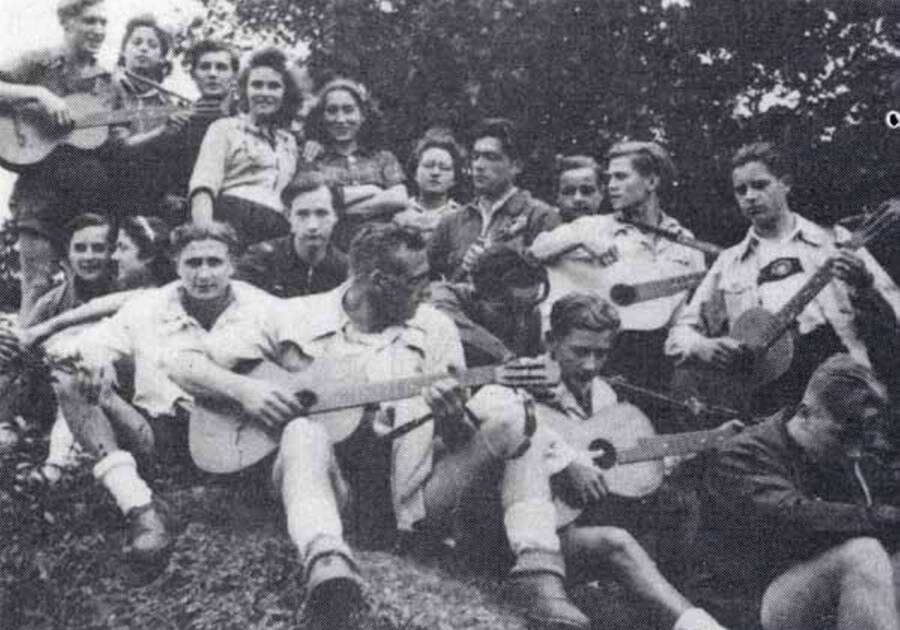
- A group of Edelweiss Pirates in Nazi Germany. The Pirates emerged in western Germany out of the German Youth Movement of the late 1930s in response to the strict regimentation of the Hitler Youth. 1938.
______
- 'Meet The Edelweiss Pirates: The Little-Known Teenaged Resistance Fighters Of Nazi Germany,' AllThatsInteresting, Aug. 19, 2019.
In stark contrast to the Hitler Youth, the Edelweiss Pirates resisted Nazism in any way they could at a time when doing so was a criminal offense. German teenagers known as the Edelweiss Pirates played an important role in Adolf Hitler’s Nazi Germany. Much like the tenacious edelweiss flower clinging to the crags of Austria’s Alps that the group was named after, these young Germans resisted Nazi indoctrination. They saw themselves as the opposite of the infamous Hitler Youth, rejecting their paramilitary structure, Nazi ideology, and gender segregation. Hailing from working-class backgrounds, the Edelweiss Pirates resisted Nazism in any way they could — all before their 18th birthdays.

- Edelweiss, a mountain flower associated with the Alps, (South Tyrol) became a symbol of the Pirates.
- THE HITLER YOUTH: According to Sally Rogow of the Vancouver Holocaust Education Center, the Edelweiss Pirates was “one of the largest youth groups who refused to participate in Nazi youth activities.” To understand the Pirates, we first have to understand what they were up against. Formed in 1922 as the Youth League of the Nazi Party, it was renamed the Hitlerjugend, or Hitler Youth, in 1926 and was comprised of German boys aged 14 to 18. Four years later, the Nazis established an equivalent organization for teenage girls called the Bund deutscher Mädel, or League of German Girls. At its height, the Hitler Youth had 8 million members, making it the largest youth organization in the world. Although the Youth initially focused on standard activities such as camping, sports, and games, it increasingly became militarized, training its young boys for armed combat.

- Hitler Youth members burn books at an unspecified location. 1938.
It soon became clear that the goal of the Hitler Youth was to indoctrinate Germany’s young people with Hitler’s aggressive, Nazi worldview. As Adolf Hitler himself described it in 1938: “These boys and girls enter our organizations [at] 10 years of age, and often for the first time get a little fresh air; after four years of the Young Folk they go on to the Hitler Youth, where we have them for another four years….And even if they are still not complete National Socialists, they go to Labor Service and are smoothed out there for another six, seven months….And whatever class consciousness or social status might still be left…the Wehrmacht [German armed forces] will take care of that.”
- Who Were The Edelweiss Pirates? The Edelweiss Pirates, or Edelweißpiraten, was a collective of local anti-Nazi resistance groups founded largely in western Germany. Aged 14 to 17, these teenagers rejected the Hitler Youth’s and League of German Girls’ dark aspects: restrictions on teenagers’ fun and freedom of thought, and training kids for military service. Many of them left school at age 14 — which was common for working-class teens at the time — in order to sever ties with the Nazis, and some dropped out of the Youth. Membership was compulsory beginning in 1936, and in 1939 — the same year World War II began — non-membership became a punishable offense. But the Edelweiss Pirates had only a few years of freedom, since they were typically forced to join the army when they turned 18...
- More, https://allthatsinteresting.com/edelweiss-pirates
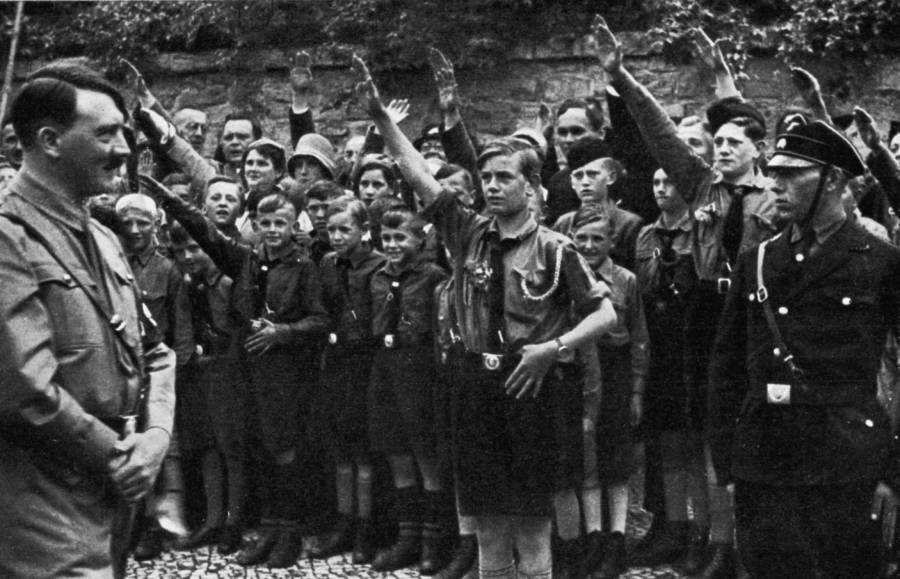
- Hitler smiles as German youth salute him in Erfurt, Germany, 1933.
_______
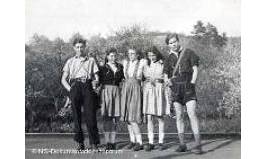
- Both girls and boys were members of the Cologne resistance.

- Surviving Edelweiss Pirates in Cologne, Germany in 2005, after finally being recognized as resistance fighters.
_______
- Other Saviors of the Holocaust, The Edelweiss Pirates, The International Raoul Wallenberg Foundation.
- 'The Edelweiss Pirates: A Story of Freedom, Love and Life.' - Excerpts, Ed:
.. In the period just before World War II, small groups (between 10 and 15 members), consisting primarily of boys between the ages of 14 and 18, began seeking each others’ company outside of the Hitler Youth. Such groups began forming in the larger cities of Nazi Germany like Hamburg, Leipzig, Frankfurt and especially in Cologne, and identifying themselves with titles like ‘swings,’ ‘packs,’ ‘cliques,’ or ‘pirates’. The Farhtenstenze, or Traveling Dudes, for instance, came from Essen, the Kittelbach Pirates from Oberhaussen and Dusseldorf, and the Navajos from Cologne. Together, the members of these groups are thought to have totaled more than 5,000, about 3,000 in Cologne alone, and although each group maintained a separate identity due to its location, all considered themselves Edelweiss Pirates. * Named for the metal Edelweiss pins and badges members wore on their collars or hats, these working-class teens became ”one of the largest youth groups who refused to participate in Nazi youth activities,” says Sally Rogow, docent of the Vancouver Holocaust Education Centre.
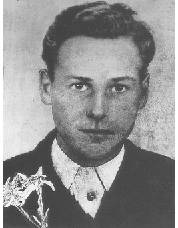
- Bartholomäus “Barthel” Schink, an Edelweiss Pirate, was hanged by the Nazis when he was only 16.
In addition to their identifying pins, their long hair, style of clothing (usually colorful, checkered travel shirts and short, dark trousers or Lederhosen, white stockings and neck scarves), and the songs they played and sang (most contrasted greatly from the German Volkish music approved by the Nazis, were by Jewish composers or were anti-Nazi in theme), were all disallowed in the Hitler Youth and served to further distance them from the group. Individual groups of Edelweiss Pirates got together in cafes, parks, or street corners in the evenings or weekends, took hikes, rode bicycles into the country for camping trips, or traveled into neighboring towns to visit fellow Pirates. It must not be forgotten that such pastimes, when taken out of context, seem exceptionally harmless. Outside of the Hitler Youth, however, they were considered criminal activities and often resulted in serious ramifications.
The Pirates usually held jobs in mills or factories, but were eventually branded as being lazy in their work ethic and as nothing more than social outcasts. Due to their similar backgrounds and common environments, and because of their small numbers, they did feel a great loyalty toward each other and often had no friends outside of their Pirate comrades. The small percentage of teens who did not join the Hitler Youth were ostracized by Hitler Youth members, however, so it was not as if the cause for the Pirates’ perceived anti-social behavior was solely one-sided. Further, they must not be mistaken for ”deprived children or delinquents,” Rogow is careful to note. ”They were simply the sons and daughters of working class parents” and too young for the military. They did have rough pasts though; a number were without parents who, because of their communist views, had been either arrested or murdered. Others were left without fathers who were away fighting in the war.
As the war progressed, so did the seriousness of the activities in which the Edelweiss Pirates participated. Pirates in Cologne ”offered shelter to German army deserters, escaped prisoners from concentration camps and escapees from forced labor camps,” says Rogow, while others ”made armed raids on military depots and deliberately sabotaged war production.” Still others played pranks on the Nazis. Julich recalls how he and his friends threw bricks through munitions factories and poured sugar water into the petrol tanks of Nazis’ cars. Other Pirates vandalized city walls, spray painting them with lines such as ”Down with Hitler” or ”Down with Nazi Brutality.” Some stole, looting food and supplies from stores or freight trains, or derailed train cars full of ammunition and supplied adult resistance groups with explosives. Pirates from different towns would ”meet in the countryside, to swap information gained from illegally listening to the BBC World Service, or to plan leaflet drops in each other’s towns so the local police would not recognize them,” Hannah Cleaver of The Daily Telegraph (London) says. Leaflets contained allied propaganda or encouraged German soldiers to quit their fighting & return to their families...https://www.raoulwallenberg.net/saviors/others/edelweiss-pirates-story/
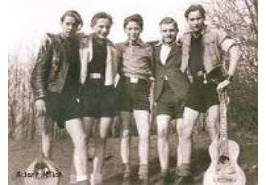
- Jean Jülich (right, with guitar) and his fellow Edelweiss Pirates.

- Jean Julich.

- The Edelweiss, a flower growing in the Alps, became a symbol of resistance for the Pirates.
_____
- Edelweiss Pirates, https://en.wikipedia.org/wiki/Edelweiss_Pirates
- *White Rose Resistance Group, https://en.wikipedia.org/wiki/White_Rose
- Swing Jugend, https://en.wikipedia.org/wiki/Swingjugend
- German Youth Gangs that Opposed Hitler: Edelweiß Pirates. House of History. (12 mins). The Edelweiß Pirates opposed the ever-increasing totalitarian grip of the Nazi regime. Their actions ranged from passive resistance to robbing munitions depots and even murder. Curiously, after World War !II came to an end, a group of post-war Nazi resistance cells coopted their name and carried out a series of bombings and attacks against the occupying Allied powers.
InfoView thread info, including edit history
TrashPut this thread in your Trash Can (My DU » Trash Can)
BookmarkAdd this thread to your Bookmarks (My DU » Bookmarks)
0 replies, 1482 views
ShareGet links to this post and/or share on social media
AlertAlert this post for a rule violation
PowersThere are no powers you can use on this post
EditCannot edit other people's posts
ReplyReply to this post
EditCannot edit other people's posts
Rec (12)
ReplyReply to this post